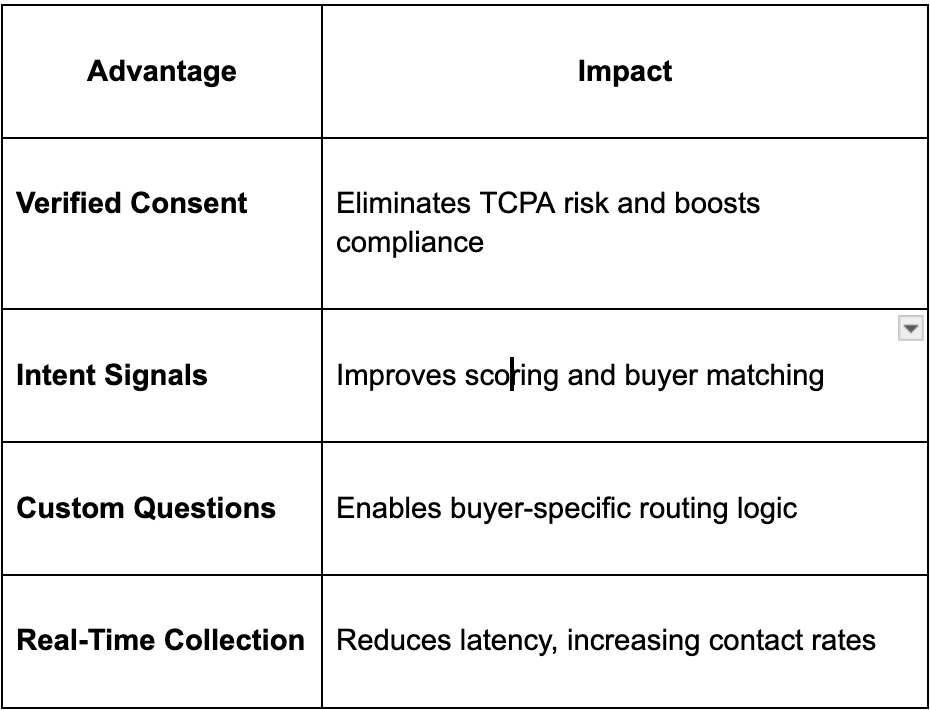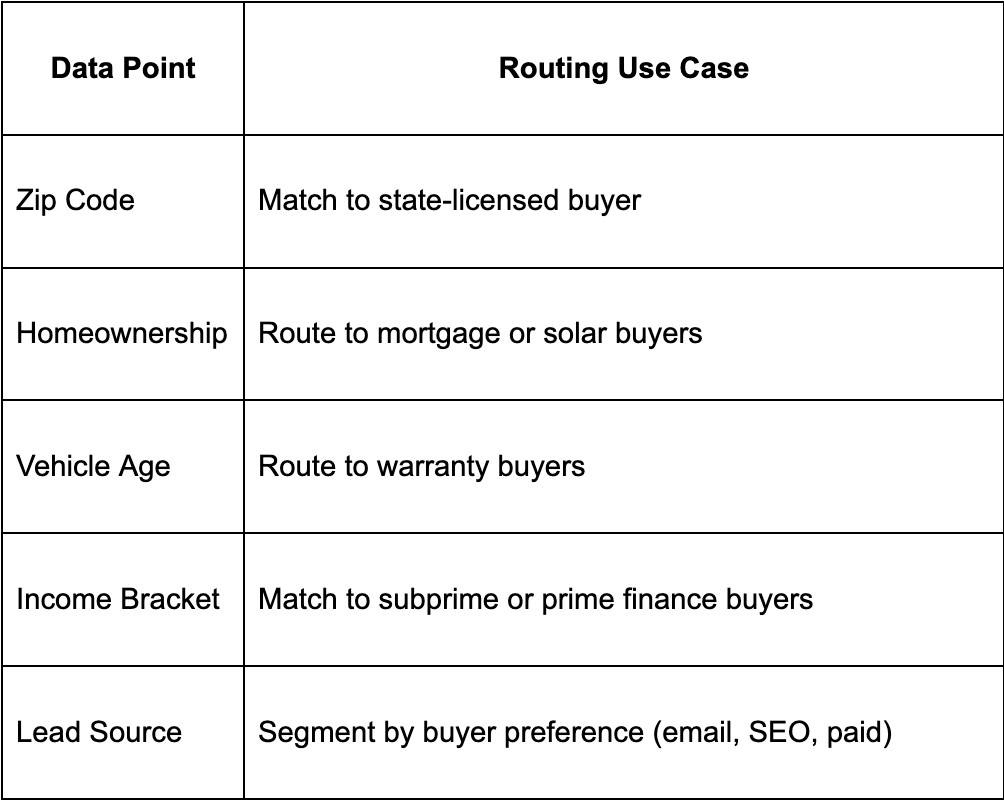In lead generation, especially within verticals like insurance, solar, home services, and financial services, data is the product. But not all data is created equal.
While many companies still rely heavily on third-party data sources and traffic exchanges, the real differentiator in today’s ping post environment is first-party data—the information you collect directly from consumers.
When properly captured, enriched, and leveraged, first-party data becomes a powerful asset: boosting lead quality, improving routing precision, and unlocking higher revenue per lead.
1. What Is First-Party Data?
First-party data refers to any information you collect directly from a user—typically through your owned channels:
- Web forms
- Quizzes or calculators
- Chatbots
- SMS opt-ins
- CRM systems
- Customer service interactions
This includes everything from name, email, and phone number to detailed behavioral signals like quiz responses, location, intent indicators, and timing.
The key distinction: you control the data collection process—and that’s what gives it its power.
2. Why First-Party Data Wins in Ping Post Environments
In ping post lead distribution, speed and quality drive outcomes. First-party data enables both:

Platforms like Standard Information are built to harness the power of first-party data, transforming every field collected into a routing decision, filter, or scoring variable.
3. The Problem With Third-Party Data Alone
Third-party data, often bought or aggregated from other publishers or exchanges, comes with multiple drawbacks:
- Unverified consent → High TCPA risk
- Stale information → Lower contact and conversion rates
- Limited detail → Can’t segment or personalize effectively
- Trust issues → Buyers don’t know the true source
In ping post bidding environments, buyers can detect poor data. If your source reputation suffers, your bids drop, refunds rise, and monetization plummets.
4. Use Case: First-Party Insurance Lead Funnel
Let’s walk through a real-world example.
A lead gen company runs a first-party quiz funnel:
- “Find the Best Auto Insurance Plan in Your Zip Code”
- The user answers 9 detailed questions (vehicle age, current provider, recent accidents, etc.)
- Consent is clearly captured (with TCPA/DNC disclosures)
- Data is immediately validated and scored
This enriched, intent-rich lead enters a ping post platform like Standard Information, where:
- Score = 92/100
- Route to Tier 1 buyers
- Sold within 400ms for $42 CPM
- Contacted in 27 seconds
- Converted in 90 minutes
Now compare this to a $5 aged lead from a third-party aggregator. There’s no contest.
5. How First-Party Data Improves Scoring
Scoring leads is only as effective as the data that feeds it. First-party collection enables:
- Behavioral scoring (clicks, time on page, exit intent)
- Response-based scoring (quiz answers, eligibility flags)
- Historical matching (based on CRM or past outcomes)
- Geo-adjusted scoring (zip code conversion modifiers)
In platforms like Standard Information, these elements can be built into dynamic scoring models—ensuring that only high-quality leads reach top-tier buyers.
6. Personalization and Tiering Based on First-Party Data
Beyond just scoring, first-party data allows for granular buyer matching. For example:

This level of targeting simply isn’t possible with blind third-party feeds.
7. How to Collect Better First-Party Data
To fully capitalize, you must optimize the data collection experience:
Form Design Best Practices
- Keep early steps short to avoid drop-off
- Ask qualifying questions early (zip, ownership, budget)
- Use multi-step logic to progressively collect detail
- Always display consent language with required checkboxes
Quiz Funnel Enhancements
- Use conditional logic to tailor questions
- Capture behavioral indicators (scroll depth, time spent)
- Pre-fill data when possible to reduce friction
- Avoid trick questions or misleading copy
The better your user experience, the higher your data integrity—and the more valuable your lead becomes.
8. Real-Time Validation Before Posting
Before a lead ever hits the ping post auction, real-time validation ensures data accuracy:
- Phone verification (line type, activity status, portability)
- Email hygiene (formatting, deliverability, blacklist checks)
- Address lookup (standardized and geocoded)
- IP checks (geo-consistency, bot filters)
With Standard Information, validation is a pre-ping step—not a post-sale bandaid. This reduces refunds and increases trust in your lead quality.
9. First-Party Data and Compliance
One of the biggest benefits of collecting data yourself? You control the consent flow.
With TCPA litigation and privacy laws tightening, platforms need:
- Explicit opt-in records
- Consent timestamps and source URLs
- Ability to pass proof to buyers during audits
- Automated filtering for DNC, Litigator, or mobile line restrictions
With first-party data, every step is documented—and fully defensible.
10. Combining First-Party Data with Ping Post Logic
Ping post is built for real-time competition. When first-party data is layered in, it becomes a competitive advantage.
Example lead journey:
- User completes quiz funnel
- Score assigned: 89/100
- Validated in 400ms
- Pinged to 4 Tier 1 buyers
- Highest bid: $47.20
- Posted in real time
- Buyer contacts in 32 seconds
- Conversion occurs same day
Now multiply this across 1,000 leads/day—the compounding revenue speaks for itself.
11. First-Party Data = Asset, Not Expense
Too many businesses view lead collection as a sunk cost. But if done right, it’s an appreciating asset:
- Build proprietary lookalike audiences
- Train internal models for future scoring
- Benchmark buyer performance by source and user path
- Sell higher-quality leads at a premium price
With Standard Information, sellers can track how first-party data performs across routing paths, campaigns, and buyer tiers—unlocking deeper insights than any spreadsheet ever could.
Conclusion: Own the Source, Own the Outcome
In lead distribution, control equals margin.
When you rely on third-party data, you’re at the mercy of external systems, poor consent practices, and commoditized pricing. But when you control the source, structure, and delivery of your lead data, everything improves:
- Higher scores
- More competitive bids
- Lower refunds
- Better buyer satisfaction
- Stronger compliance
- Repeatable success
That’s why first-party data + ping post isn’t just a nice pairing—it’s the blueprint for profitable scale.
And with tools like Standard Information, you don’t just collect data—you activate it.
FAQs
Q1: What's first-party data when we talk about getting leads?
First-party data is what you get straight from people interacting with your stuff – like when they fill out a form on your website, take a quiz, chat with you online, or sign up for texts. Since they agreed to give you the info directly, it's usually more correct, follows the rules better, and is worth more than buying data from someone else.
Q2: Why is using your own data better for ping post?
In ping post, getting leads is about being fast and having good quality. Your own data means you *know* people said it was okay to contact them, plus contact info is newer. Because you understand why they gave you their info, you can rate and send leads to the right place better. Data you buy from other places often isn't that good or clear, so people won't offer as much, and you might have to give refunds.
Q3: How does Standard Information use first-party data to send leads to the right people?
Standard Information takes your data and uses it to decide where to send each lead. We rate and check each lead right away and then match it with buyers based on how well they've done before, how often leads turn into sales, and if the buyer follows all the rules. This makes sure the best leads go to the best buyers ASAP.
Q4: How does using my data help with following the rules and making more money
When you're in charge of how you get the data, you're also in charge of getting permission. First-party data keeps track of who said yes to being contacted, when they said it, and where the info came from. This lowers the chance of getting in trouble with the law and makes buyers trust you more. Because of this openness, leads are worth more, you get more sales, and you make more money overall.